The One Thing You Have to Eat in Every State
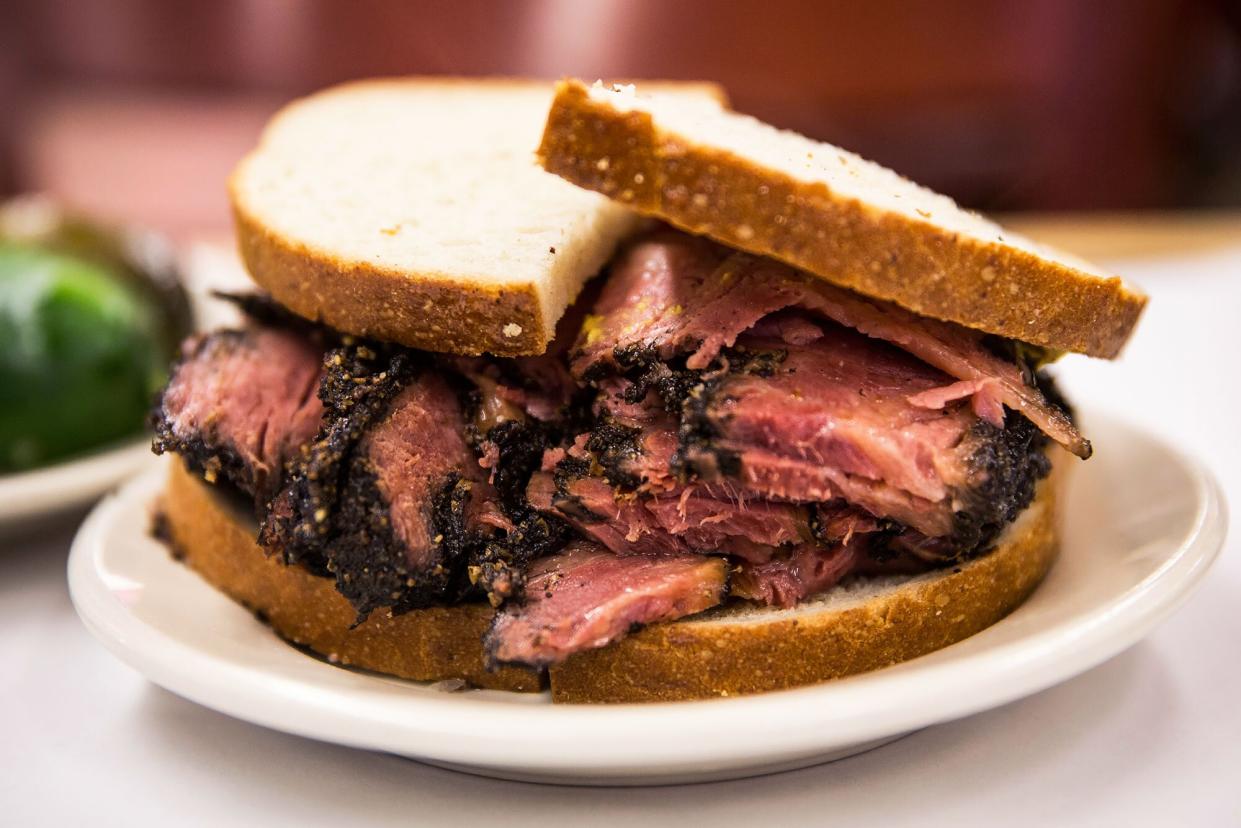
Andrew Burton / Getty Images
Whether we're talking about the best barbecue, hot dogs, diners, or doughnuts in America, our lists are backed by a serious amount of on-the-ground research. Drawing from Food & Wine editors' extensive travel and passion for eating, senior editor David Landsel spotlights the most essential, most important food institutions in the country — the ones we hope stick around for decades to come.
From the start of his career as a travel and food writer in the late 1990s, Landsel has traveled to each of the fifty states for research more times than he can count, with many revisited at least once during a typical travel year. As a magazine, over the decades of celebrating the very best of food and drink, we've come to greatly appreciate each state's unique contributions to American food culture — that's how this list came to be. It's a highlight reel of the very best American food we've covered over the years, including write-ups we've published of our all-time favorite restaurants.
This is the list to end all lists, an answer to the question: If you had time to eat one thing in every state, what would it be? From Alaska to Florida, Maine to California, we've chosen regional treats that you just can't miss.
Alabama: Barbecued pork ribs
George and Betty Archibald started selling pork barbecue from the utilitarian outbuilding behind their Northport home in 1961, but Archibald's Bar-B-Q feels much older, like it belongs in one of those living museums. The honking-huge pit opens directly to the front counter, where you'll find the cashier pulling double duty with the basting mop, ensuring racks of giant pork spare ribs come to you dripping with orange-red sauce. The ribs here do not win beauty prizes, scraggly and wet and guaranteed to leave a mark all over your front, but they're some of the most memorable in the country. This is no small feat for a little outfit one bridge away from Tuscaloosa and Dreamland BBQ, where John "Big Daddy" Bishop grew another humble rib joint into one of the South's best-loved destinations for barbecue.
Alaska: Salmon
Real talk — by the time that mountain of king crab makes it to your table, whether you're in Anchorage or Atlanta, Alaska's most coveted crop has already traveled pretty far from the Bering Sea. This means it will usually have been frozen, and it'll cost you. The real joy of eating in Alaska revolves around the nearly-limitless quantities of salmon pulled from those chilly northern waters. Cheap is probably not the word, but some of the best fish you'll ever eat is affordable and plentiful, from deep-red sockeye to the rare, elegant king. From fish and chips at the humble White Spot Cafe to elegant dinners at the Crow's Nest, you're never far from fine, fresh seafood in Anchorage. If you can't make the trip, order a can or three of the smoked Southeast king from Wildfish Cannery, one of the best domestic purveyors on the booming tinned fish scene.
Arizona: Sonoran hot dogs
Tucson, with its thousands of years of documented food heritage, was not named a UNESCO City of Gastronomy for nothing. We'd like to think it had a great deal to do with the Sonoran dogs. More often than not, these beauties come from El Guero Canelo, which has been serving the city for nearly thirty years. Bacon-wrapped and tucked into a soft, steamed, house-baked bolillo, we'd eat them just like that, but the joy of the Sonoran dog — popular on both sides of the border for generations — is that there's so much more going on: think beans, onions (raw and fried), mustard, mayo, and the house jalapeño salsa.
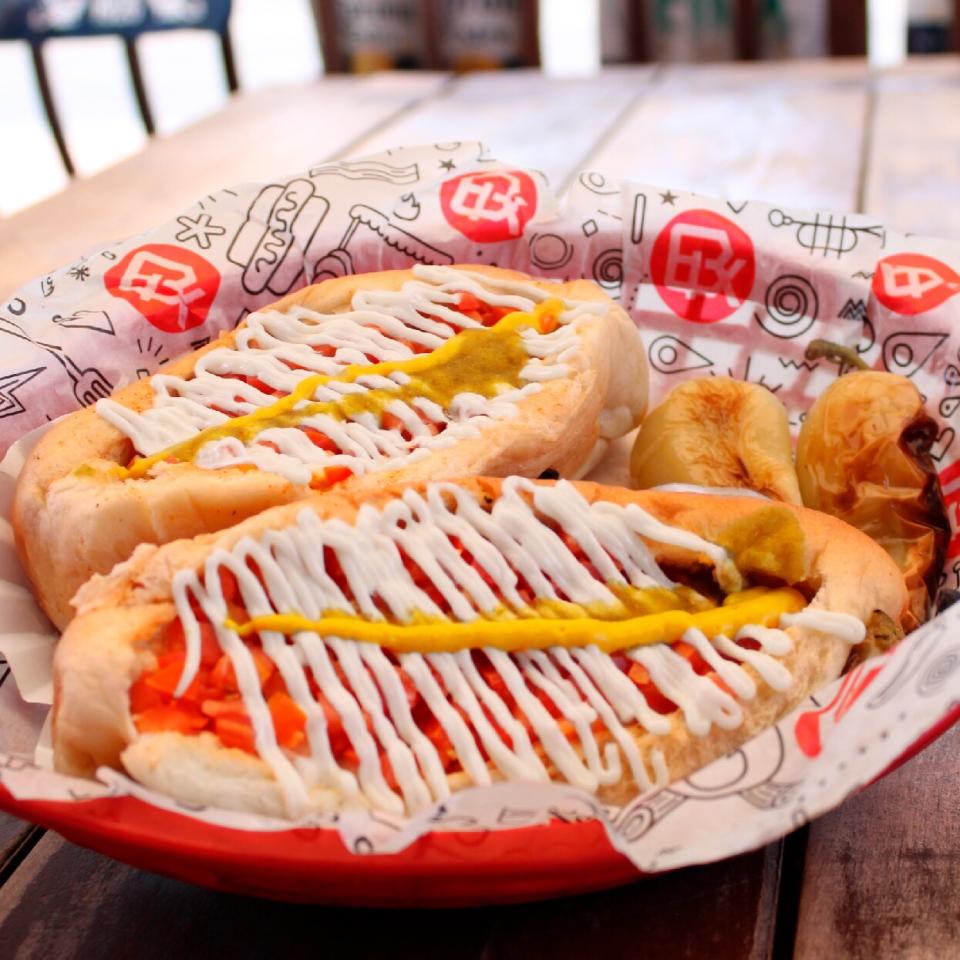
Carlos Clark
Related: The Next Great American Food Cities
Arkansas: Barbecue sandwiches
Some day we'll have a National Barbecue Hall of Fame, with an entire exhibit dedicated to sleepy Marianna's quietly magical Jones Bar-B-Q. The Mississippi Delta legend is often called the country's oldest Black-owned restaurant, having been around at least since the beginning of the 20th century. James Jones took the place over from his father, long before many of us were born. The recipe for wild success — the kind that has the place selling out of hickory and oak-smoked pork shoulder, sometimes just an hour after opening — has remained simple: a cinder block pit, piles of wood, and plenty of patience. This is where you come for one of America's finest pork sandwiches, all smoke and vinegar and flecks of fat, topped with a mustard-tinged slaw and served on basic white bread.
California: Tacos
For a city modernized around the car, Los Angeles was once a relatively unadventurous place, cut to invisible ribbons by lines of demarcation not printed in the Thomas Guide. Depending on where you lived, growing up Angeleno meant inheriting an entire list of dos, don'ts, wills and won'ts, unique to your situation. That was then, before the great tech-enabled awakening, before the late Jonathan Gold, before Google Maps and delivery apps and Instagram. And here we are today, in the 21st century, with almost nowhere in the Southland the locals won't go, as long as you promise them they'll be well fed. Not that you have to go very far.
Just over the Los Angeles River, nearly in the shadow of the vastly expanded downtown skyline, Boyle Heights was once on the other side of one of those invisible lines. By now almost everyone knows that you're just a short ride away, down Olympic Boulevard, to Mariscos Jalisco, which specializes in fried corn tortilla tacos dorados stuffed with shrimp and topped with fresh salsa and avocado. You order and sit on the wall like everyone else, or go inside the windowless church basement-like space and grab a table. Here, you're minutes by car from some of the most exciting restaurants in the city, so next, you go everywhere, from the historic East Side neighborhoods all the way out to the beach. Barely a block away, Tacos Y Birria La Unica sets itself apart in a city where the birria taco, filled with a rich, intricately seasoned stew popular in Jalisco, is nearly ubiquitous. Elsewhere in the neighborhood, you'll find some of the best carnitas north of the border at Carnitas El Momo. You used to have to know your way into the semi-covert backyard operation; these days, there's usually a truck right in the street.
Colorado: Colorado Mex
From the pre-colonial communities near the New Mexico line to the sleepy big city of Pueblo, and all throughout the Front Range, Colorado's Southwestern heritage may not always jump out at you, but stick around, and you'll start to notice things. You'll find delectable local chiles on the menu at classic coffee shops and burger joints in Puebla, blast-from-the-past diners in thoroughly Anglo-fied Colorado Springs serving sides of green chile with breakfast, and carloads of hungry night owls flocking to Chubby's, where the thing to order is a Mexican hamburger, almost entirely unique to the Denver area. This hybrid creation comes out looking like a perfectly respectable burrito, made with a flour tortilla, swimming in a pool of green chile. Turns out, there's a burger patty stuffed in there, along with refried beans and chicharrones. Modern Colorado can brand itself however it wants, but to us, it'll always be the Southwest state that (sort of) got away.
Connecticut: White clam pizza
For as long as Americans have been eating pizza, New Haven has been one of America's most important pizza cities, a designation it takes extremely seriously. More than a century after a young immigrant named Frank Pepe began serving thin-crusted, coal-fired Neapolitan pies out of his Wooster Street bakery, Frank Pepe Pizzeria Napoletana has restaurants all over the region. You can still get that same pizza: coal-fired, thin, and a little chewy, the way a New Haven pizza should be. It's one of the finest pizzas in the country, as is the one at Sally's Apizza (say ah-beets), also coal-fired. Just down the street, Sally's was founded in the 1930s by Salvatore Consiglio. Here, the blackened edges contrasting with that blood red sauce is breathtaking, before you even bite in. Chances are, however, you're in the market for a more modern New Haven classic — the white clam pie, a tomato-less pizza topped with freshly-shucked littleneck clams. While Pepe's has achieved the most fame, the one at Zuppardi's Apizza in West Haven has been a sleeper hit for years — not terribly famous outside of the region, but absolutely one of New Haven's most essential pizzas.
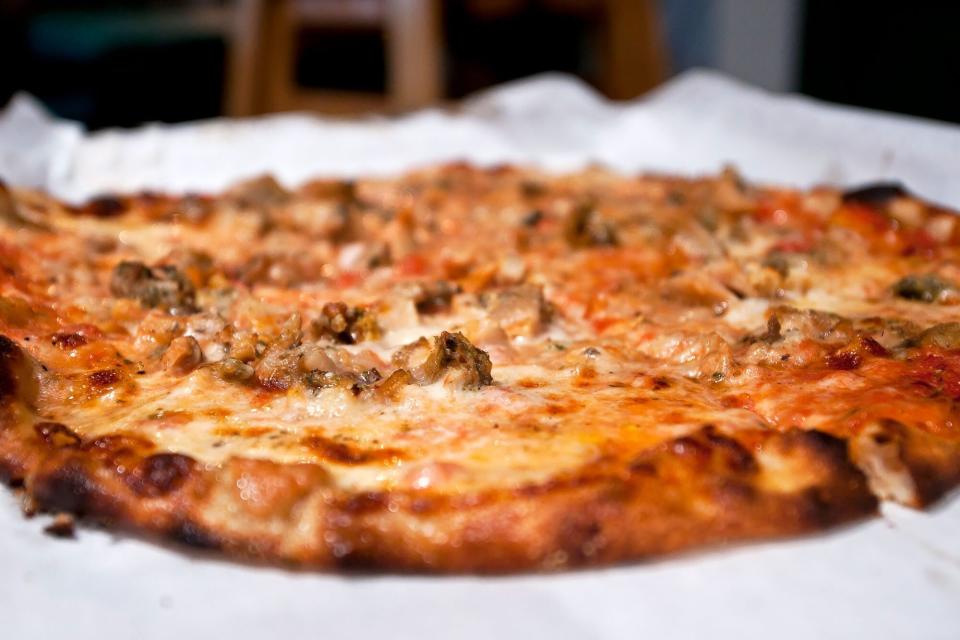
Michael Talalaev / Getty Images
Delaware: Scrapple
Widely appreciated in its spiritual Mid-Atlantic homeland but mostly unheard of elsewhere, Pennsylvania Dutch cooking is honest, straightforward, affordable, and deeply loving. While perhaps ill-equipped to survive in these visual times, this food is stripped down to the bare walls. From apple dumplings to pot pies crammed with thick, homemade egg noodles, there's a lot to be comforted by, but for many, the conversation starts at sunrise with fat, fried slices of scrapple, the region's favorite snout-to-tail breakfast meat.
As any proud resident of the First State can tell you, Delaware is the leading commercial producer of these gray loaves of pork off-cuts, sometimes including offal, and molded with cornmeal or buckwheat flour. Scrapple is a dinosaur dish, the sort of thing you'd expect to have been made extinct the moment producers figured out how to make bacon and pork sausages affordable and plentiful, and yet, here we are. Typically sliced thick, then fried until the outsides are crispy and golden brown, people eat scrapple as a side with eggs and toast, or perhaps on its own little plate with lots of maple syrup. One of the best ways to get your hit of funky goodness is to put a big slice of scrapple in a breakfast sandwich, preferably on a fresh-baked potato roll, along with that other regional favorite — Cooper Sharp processed cheese. Habersett's has been producing scrapple since 1863, and they ship, too.
Florida: Cuban Sandwiches
Just over a century ago in Tampa, Spanish-Cuban immigrant Casimiro Hernandez Sr. created the mixto sandwich at the Columbia Restaurant, a sandwich he hoped would honor the contributions of the many immigrants who breathed life into the Ybor City neighborhood and Tampa in general. The sandwich had everything: ham, Genoa salami, mojo roast pork, Swiss cheese, pickles, and mustard. The sandwich and the restaurant are still with us, thankfully, and like always, you'll find yours served on Florida's best Cuban bread, baked since 1915 just around the corner at La Segunda. Florida is a big state of course, filled with people who have a lot of ideas about where to find the best Cuban-style sandwich. Down south in Miami, make the slightly chaotic Enriqueta's your first stop, where they'll stuff croquetas into your Cubano if you like, and yes, you do like, very much so.
Georgia: Biscuits
The uninitiated outsider might look at your typical gas station on a lonely Georgia back road and think, emergencies only. For locals, there's only one question, particularly early in the morning — do they have biscuits? If so, how are the biscuits? Throughout the largely rural state, you'll find otherwise unremarkable establishments selling the kind of classic, homemade biscuits people in other parts of the country can only dream of. Chicken biscuits, breakfast biscuits, breakfast biscuits with chicken on them — Georgia doesn't necessarily venture into new territory compared with other states down South. A few days in, you might forget other kinds of sandwiches exist, and would that be such a bad thing? Not if you could have the likes of Stilesboro Biscuits, in Kennesaw, at your beck and call, where people wait patiently every weekend for their sausage egg and cheese biscuit. The same goes for one of the best breakfast sandwiches in Atlanta, served at Home Grown— it's stuffed with fried chicken, doused in rich sausage gravy, and best consumed with a knife and fork.
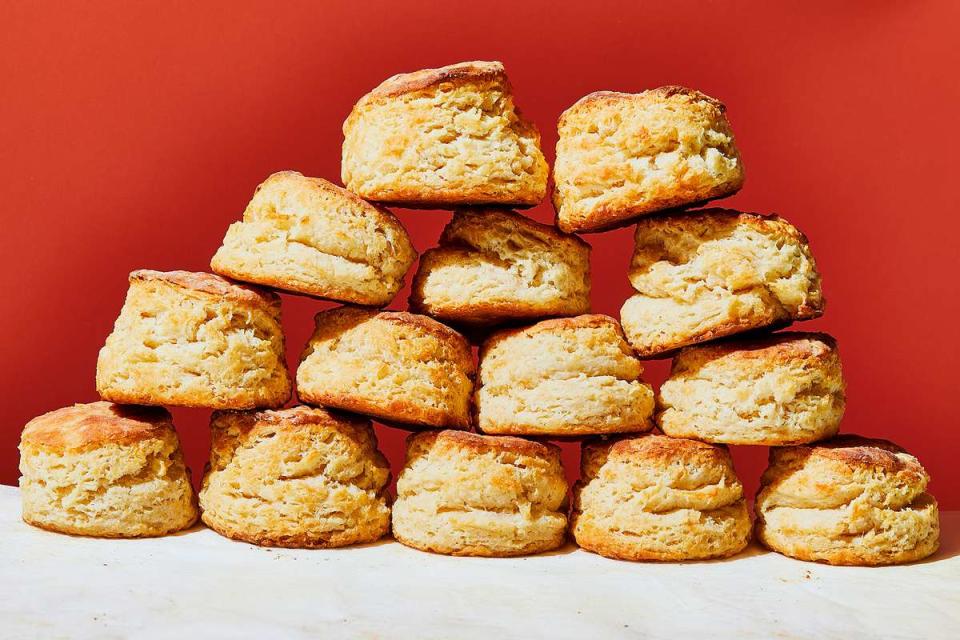
Photo by Jennifer Causey / Food Styling by Torie Cox
Hawaii: Malasadas
Here's a bet. Long after the specifics of your first, magical Aloha State adventure fade into a happy haze of sun and sand and supermarket poke, we're guessing you'll remember the time you ate your first malasada at the no-frills Leonard's Bakery in Honolulu, and you'll remember like it was yesterday. Brought to the islands by Portuguese immigrants long ago, most malasadas we've found in Hawaii don't bear much of a resemblance to the scraggly pieces of fried dough served up sugared and hot in the old country, but never call the golden brown orbs, which they have been selling at Leonard's since the 1950s, just another doughnut, either. Classic cinnamon sugar-dusted will always be a fine accompaniment to a bold cup of 100% Hawaiian coffee, but the custard-filled puffs are gorgeously extravagant, good for any (and every) time, and still sold cheaper than you can imagine.
Idaho: Basque food
Basque culture has been part of life in the Mountain West for centuries now. To this day, Boise, Idaho's suddenly go-go capital city, remains a focal point for Basque-American life, with the continent's only museum dedicated to Basque tradition and festivals drawing Basque people from all over the world. Year-round, you won't go very far in Idaho without coming across some Basque dishes, or better still, entire restaurants dedicated to one of the world's most intricate cuisines. Epi's Basque Restaurant recently clocked twenty years in Meridian, serving countless croquettes, roast leg of lamb, and Gâteau Basque. In downtown Boise, your eggs at Goldy's Breakfast Bistro come with a side of Basque chorizo, an Idaho favorite.
Illinois: Italian beef
The exact origins are tough to pin down, but the legend of Italian beef, pride of Chicagoland, is too good to prove incorrect. Immigrants working the stock yards would bring home the tougher cuts, or so the story goes, seasoning and slow-cooking them into submission, yielding an aromatic, irresistible jus. Sliced thinly and served on Italian bread, the beef made a sandwich that Chicagoans couldn't get enough of. Since the 1930s, Italian beef has been one of Chicago's finest quick meals, and today, the sandwich isn't much more complicated than it was at the beginning. The key components are an absorbent commercial-grade roll from a local institution like Gonnella, shards of slicer-cut beef, liberal amounts of giardiniera, hot or sweet peppers, and as much of the jus (or gravy) as you want. Hot and Wet, Sweet and Wet, Hot, Sweet and Wet, or even Dry (but why would you?) — try it all the ways, at all the places.
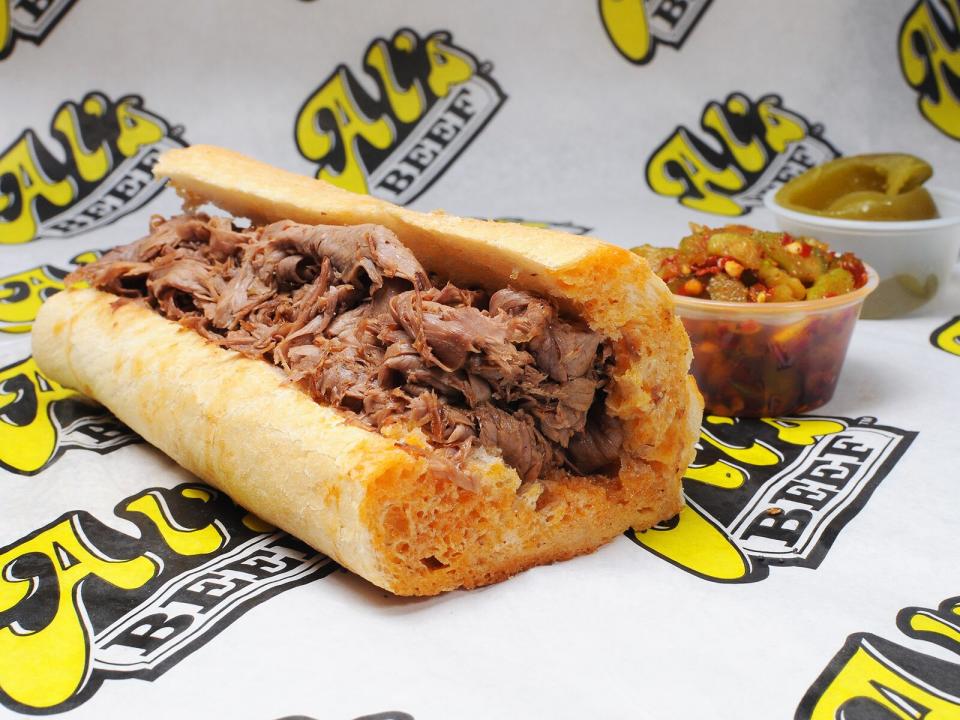
Courtesy of Al's Beef
Let us know how you get on; we'll be at Johnnie's in Elmwood Park, not far from O'Hare, where they still roast their own beef in-house. Their combo sandwich, made not only with the best beef in town, but also a whole charcoal-grilled Italian sausage, is a riot of flavor and texture. For even better results, top with giardiniera, all the peppers, and a gravy deep soak.
Indiana: Smash burgers
Long before the smash burger was appropriated, repackaged, and sold at double the price elsewhere, Hoosiers were gobbling them up. The now-internationally popular style can be found everywhere throughout Indiana, from regional chain restaurants to vintage mom-and-pop operations like Workingman's Friend, a near-ancient tavern tucked into a part of Indianapolis you probably weren't looking for. More than a century old, this woman-owned and -operated restaurant has remained in the same family of Macedonian immigrants since 1918. Racks of Cheez-It packets, a DeKuypers display collecting dust, and a forgotten half-pot of coffee on the burner pass for decor at the glass-brick bar backlit by pink neon; belly up and order a double, cheeseburger that is, so smashed it's not even funny, served Big Mac style with bread in the middle, plus cheese on both patties, shredded iceberg and a bit of mayonnaise spread thinly on the bun. (Ketchup is always Red Gold, the preferred local alternative.) One of Indy's most essential bites, in one of the Midwest's best bars.
Iowa: Pork tenderloin
From top-notch bacon at Vande Rose Farms to some of the New World's finest prosciutto at La Quercia, America's largest pork producer does a bang-up job with one of its main exports: the pork tenderloin. Locally one of the most popular ways to get a hit of the other white meat, the cut is less renowned beyond state lines, and we're never sure why. Who wouldn't want a massive hunk of center-cut pork loin, pounded into submission, breaded or battered and fried until perfectly crisp, still juicy on the inside? Typically found hanging out of a standard size bun with mustard and pickles, pork tenderloin makes the best sandwich in Iowa. Not only does the local pork producers association hand out awards for the best tenderloin each year, but the state also has a Pork Tenderloin Trail, featuring twelve of the best makers. Breitbach's Country Dining, up above the Mississippi River in Balltown and the oldest bar and restaurant in the state, does an excellent job.
Kansas: Fried chicken dinners
On a rural road in Crawford County, so far into the southeast corner of the state you're practically in Missouri, two vintage fried chicken restaurants stand side by side, keeping each other company in the middle of nowhere. For generations, hungry families from Pittsburg and other small towns around ventured out for their semi-regular dinners, parking at either Chicken Annie or Chicken Mary. The lore behind these two very similar restaurants runs deep; they even inspired a bestselling novel called The Chicken Sisters. Most people are just happy both establishments are still around, serving big plates of dusted and crusted chicken, served with classic sides like German potato salad and cut green beans.
The regional passion for homespun, frozen-in-time dinners appears to be nearly limitless. Also in the area, you have Crawford's Chicken Dinners, on a farm near Mulberry since the 1940s. Closer to Pittsburg, Barto's Idle Hour, almost nearly as old, calls itself a steakhouse, but most of the tables in the crowded dining room seem to be interested in — you guessed it — the chicken.
Kentucky: Mutton barbecue
When craving barbecue, most Americans are probably not thinking about mutton. Unless, of course, they're from Kentucky, where the hickory-smoked, mature sheep meat, chopped and served in a tangy, musky vinegar dip, is as central to the culture as brisket in Texas or whole hog in North Carolina. Spiritual home-wise, it's the Ohio River city of Owensboro that you're after, where the Moonlite Bar-B-Que Inn and Old Hickory Bar-B-Q have been smoking up a storm for generations. The meat is made tender with lashings of Worcestershire sauce, lemon juice, vinegar and an array of seasonings and spices.
Louisiana: Classic New Orleans fine dining
New Orleans isn't short on restaurants where honoring tradition is the order of the day. At Garden District anchor Commander's Palace, dine in the coveted, glass-walled Garden Room, where you'll order the reasonably-priced multi-course lunch, starting with some of the planet's best garlic bread and one of the restaurant's famous 25 cent martinis (weekdays only). When the restaurant went through its famous mid-1970s rebirth, it brought the late Paul Prudhomme into the national spotlight. The early-era celeb chef went on to continue his work, preaching the gospel of blackening all things Louisiana at K-Paul's, which lasted nearly half a century. You still have your choice of grandes dames in the French Quarter, where Antoine's is now 180 years old. It's Friday lunch at Galatoire's, however, that still feels like a private soirée you've managed to crash. So sought-after are the tables in the mirrored and tiled first floor dining room that a line snakes down Bourbon Street. Once in, don't rush — relax, toots, it's a party — a party that has been known to stretch all the way up to the dinner hour.
Maine: Lobster rolls
The lobster business is a temperamental one, sometimes likened to a ride on a bucking bronco. While shuttered restaurants and a reduction in commercial flights during the pandemic wreaked their share of havoc, these challenges were no match for an industry that already knew a thing or two about resilience. Besides, for many people over the last few years, self-care apparently meant buying a ton of lobster, with crowds swarming Maine's lobster shacks for the state's iconic summertime treat — the lobster roll.
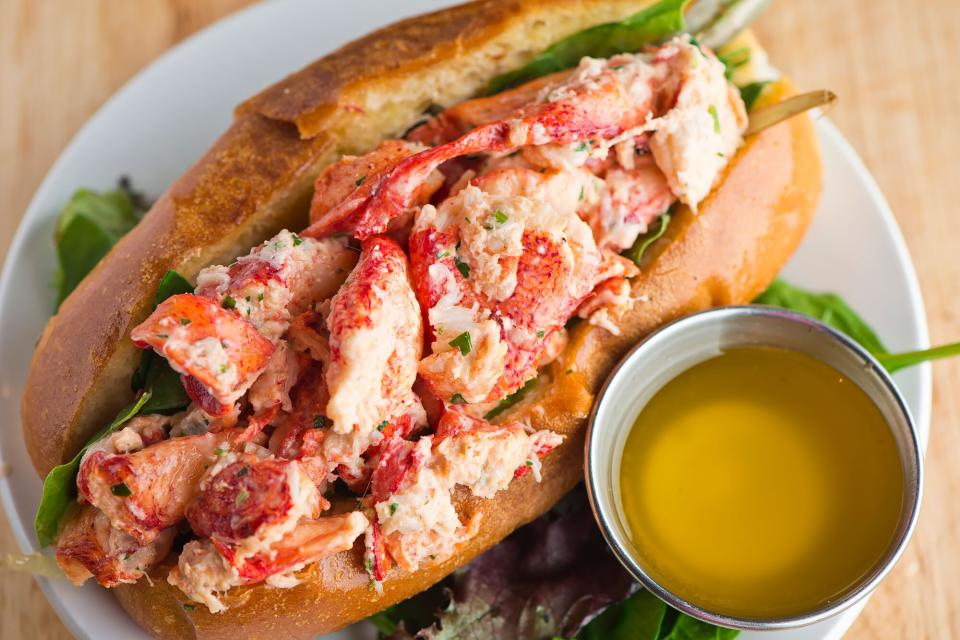
Getty Images
Classically, the Maine version is just cooked and chilled lobster tossed with a bit of mayonnaise, scooped onto a toasted and buttered split-top roll. You can find this everywhere; price, portion control, proximity, and happy childhood memories seem to inform most discussions about who makes them best. At Bite into Maine, a seasonal operation in the Portland area—can't beat their seaside food truck at the iconic Portland Head Light — you can choose from an array of preparations, from lobster with wasabi mayo to a roll with coleslaw and celery salt. During the winter, head to the year-round Eventide Oyster Co. in Portland for their memorable contribution — a Connecticut-style roll, except with brown butter.
Maryland: Blue crab
There are plenty of great breakfasts in Baltimore, but nothing so iconic as the pre-lunch scene at Faidley's in the workaday Lexington Market, where locals still crowd in for crab cakes and beers, generations after the family-owned spot opened. To be a real Marylander means to love blue crab, pride of the Chesapeake, and to love it deeply, perhaps even more than your own mother. This sort of love requires that you do not always trouble yourself with such specifics as seasonality, even if you know that fall is best. All summer long, the faithful fill outdoor decks everywhere from Baltimore's Inner Harbor to the Eastern Shore for their traditional crab feasts, mallets and canisters of Old Bay at the ready. Down along Mill Creek in Annapolis, Cantler's Riverside Inn was opened in 1975 by longtime waterman Jimmy Cantler. Here, happily, you'll find most of the crabs are pulled from local waters before being steamed and served by the pile on paper-covered tables.
Massachusetts: Ice cream
When considering the recent ice cream boom across the country, one might be tempted to think of Toscanini's in Cambridge — dating to the early 1980s — as a classic. But around here, Gus Rancatore's legendary scoop shop is practically a youngster, coming around roughly a full decade after the pioneering Steve Herrell laid the groundwork for modern American ice cream culture. All these years later, Tosci's feels just as fresh and relevant as ever, scooping up two of the most essential flavors in the country: the punch-in-the-schnoz burnt caramel, and fudgey/nostalgic cocoa pudding. Don't leave Cambridge without a scoop or two from Christina's Homemade Ice Cream, another essential piece of American ice cream history going back to the early 1980s. To this day, very few shops are quite so good on flavors as Raymond Ford and his talented crew; don't miss the Bailey's Irish Cream.
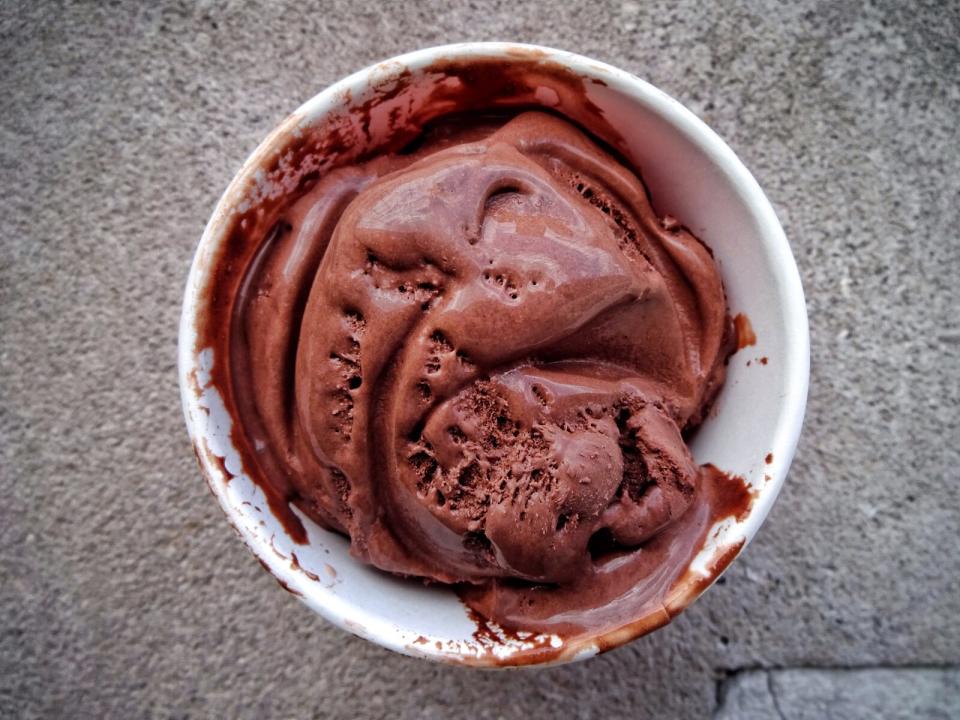
David Landsel
Michigan: Pasties
Introduced to the Upper Peninsula in the 1800s by English miners and later adapted by Finnish immigrants, the humble Cornish-style pasty remains almost as much a part of the cultural furniture north of the Straits of Mackinac as in their homeland of Cornwall. The debate on who makes the best rages on. Only one thing to do, then, and that's try as many as you can. Lawry's, serving Marquette since the World Wars, sticks close to the classic ideal: flaky crust, properly crimped along the edges, stuffed with beef, potato, onion, and rutabaga. Driving around the Upper Peninsula, you'll find more pasty purveyors than they've got in Cornwall (okay, exaggerating) on the way to Toni's Country Kitchen in post-industrial Laurium, but there's something about the regional staple baked up at this humble diner. A complete throwback with the same owner since the early 1980s, Toni's serves pasties that are a symphony of beefy, onion-y flavor. Who cares if it's not lunch time, yet; this is the perfect food for a cold morning on the beautiful, rugged Keweenaw Peninsula, with its miles of Lake Superior coastline.
Minnesota: Whitefish
Containing more Omega-3s than pink or sockeye salmon, and irresistibly light and sweet when served fresh, the humble Great Lakes Whitefish has countless charms, especially when pulled from the chilly waters of Lake Superior. The best fish are the ones you catch yourself, but fortunately, there are plenty of people willing to do the job for you. Park up by the docks in Grand Marais and order the whitefish and chips at Fisherman's Daughter. On the drive up the legendary Highway 61, stop by Northern Waters Smokehaus in Duluth, where they'll wrap a pound or three of smoked local fish to go — that, or they'll ship it right to your front door.
Mississippi: Hot tamales
The first time a dish of tamales makes its way to your table at a restaurant anywhere along the Mississippi Delta, from south of Memphis all the way clear down to New Orleans, you might be a little confused, if you're used to tamales from the Southwest or Mexico. First off, a Mississippi tamale is often quite small, and typically made with cornmeal and ground pork. It's frequently boiled, and served in a variety of ways — sometimes in husks, sometimes in parchment, sometimes unwrapped and tossed into a ceramic dish, then doused in a musky hot sauce akin to spicy gravy. As with many aspects of Delta culture, there are a lot of stories surrounding the tamale's long and winding journey here, but the simplest, as usual, is likeliest the closest to the truth. One hundred years ago, when migrant laborers from Mexico would come to harvest cotton, the dish was introduced into the local population, and it evolved over time. Today, an order of Mississippi tamales feels like a direct line to the past, as do so many of the restaurants where they're sold, which is nearly all over the state now, from Doris' Hot Tamales in coastal D'Iberville, all the way up to Hot Tamale Heaven in Greenville, and Abe's Bar-B-Q in Clarksdale.
Missouri: Barbecued burnt ends
Back in the 1970s, Calvin Trillin famously wrote about the burnt edges of brisket handed over the counter for free at Arthur Bryant's in Kansas City, a restaurant he considered to be the best in the world. Everyone in town has an opinion about the long-running institution, but there's still nothing quite like your first burnt ends sandwich, an unholy mess of bark and meat and sauce. For many Americans raised on sanitized chain barbecue restaurants, Bryant's provides an excellent reminder of exactly what barbecue is supposed to be. In these modern times, an easily-distracted Kansas City's attentions have been pulled in all sorts of directions, but three essentials remain at the core of the experience — Bryant's, around since 1908; Gates Bar-B-Q, particularly the original location, mostly for the ribs; and LC's Bar-B-Q, out on the shaggy fringe of the city.
Montana: Pork chop sandwich
The quickest path to understanding Butte is learning that there used to be roughly 100,000 people living in what was once the wealthiest mining district in existence. Today, the city has just over 30,000 inhabitants, and the money is mostly elsewhere, but the town isn't going anywhere, with its grand, boom period architecture and handful of classic restaurants that double as time machines. Pork Chop John's dates to 1924, when John Burklund began selling sandwiches out of his van, a business lucrative enough that he ended up in a brick-and-mortar location not long after. The original location is still in operation — just ten stools at a counter — and the business has now been in the same family since the 1960s. The pork chop sandwich — pork tenderloin, breaded and fried, on a roll with mustard, onion, and pickle — is rather iconic. Make ours a double.
Nebraska: Runza
Brought to the Great Plains by the large community of Volga Germans that resettled here as early as the 1870s, the bierock, a filled yeast roll that's typically stuffed with beef, cabbage, onions and seasonings, can be found in various forms and shapes throughout the region. You'll find them year round, but it's during the fall, when the weather begins to cool, that bierock fever tends to spike; no quarantine necessary, and the only cure is to eat more of them. Today, Nebraskans will commonly refer to these hand-held meals as a runza, greatly popularized by a restaurant chain of the same name. To go truly old school, head to Sehnert's Bakery in McCook, one of the state's best bakers for generations.
Nevada: Casino buffets
While Pennsylvania Dutch Country was tinkering with the buffet long before modern Las Vegas, of course it was the casinos that took the idea to the next level. The first all-night buffet popped up around the Second World War, with one very simple objective — to keep people gambling. Over the years, the American buffet has become as diverse as the country itself, and Las Vegas has emerged as the standard bearer.
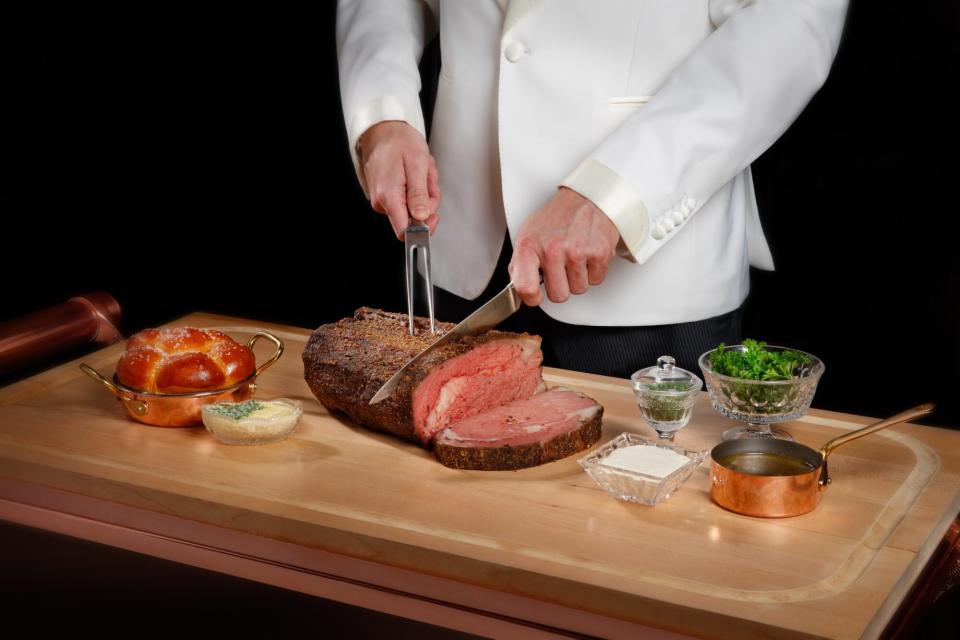
MGM Resorts International
Way back in the heady, early days of the most hyped resort to hit the Las Vegas Strip, the whiz bang genius in charge of the best buffet in the city joked to a reporter that the reason everyone loved it so much was because there was no food budget, just a blank checkbook. Things have calmed down now, of course, but anybody arguing for another best buffet in Las Vegas should be treated with due skepticism. All this time later, The Buffet at Bellagio is about as good as it gets. Begin your morning, before the crowds show up, sitting in the sun-splashed conservatory, which was made over during an extensive pandemic-times closure. Take it easy over coffee and pastries, or smoked salmon and eggs — just some light nibbles, you know, while you think about getting serious. Any morning is a good morning, but dinners and weekends are when the stops really come out — oysters, crab legs, the works.
New Hampshire: Pancakes and maple syrup
They don't own maple syrup — or breakfast — here in "Live Free or Die" country, but there's something special about a sugaring season road trip to one of New Hampshire's long-running pancake houses, some of the finest in the land, the sort of place where modern America can seem very far away. Polly and Wilfred Dexter dreamed up a way to promote their maple business back in the 1930s — they'd open a little place, and start serving pancakes. Today, Polly's Pancake Parlor, still in the same family, has evolved to become one of New England's most iconic places for breakfast and beyond, even if it is all the way north in Lincoln. Perched on a hillside and offering panoramic views, perfect mornings in the White Mountains start here, with stacks of griddle cakes and generous sides of quality, locally-smoked bacon.
New Jersey: Pizza
Imagine, if you will, what New York's pizza culture might look like without the world beating a path to its door. It would look like New Jersey, working hard, often without the interruption of sustained attention, serving a local clientele that has no trouble holding them accountable. In recent years, thrilling new standouts like Razza and Bread & Salt have lured more than a few outsiders, thanks to glowing reviews (all true, every word) in the New York Times. Besides having some of the best new pizza in America, New Jersey also has some of the best oldest pizza in America, down in Trenton, where they don't call it pizza at all, but rather tomato pie. Here, that means a relatively small amount of mozzarella on a nice, thin crust, with a generous amount of crushed tomatoes up top.
Related: The Best Pizza in Every State
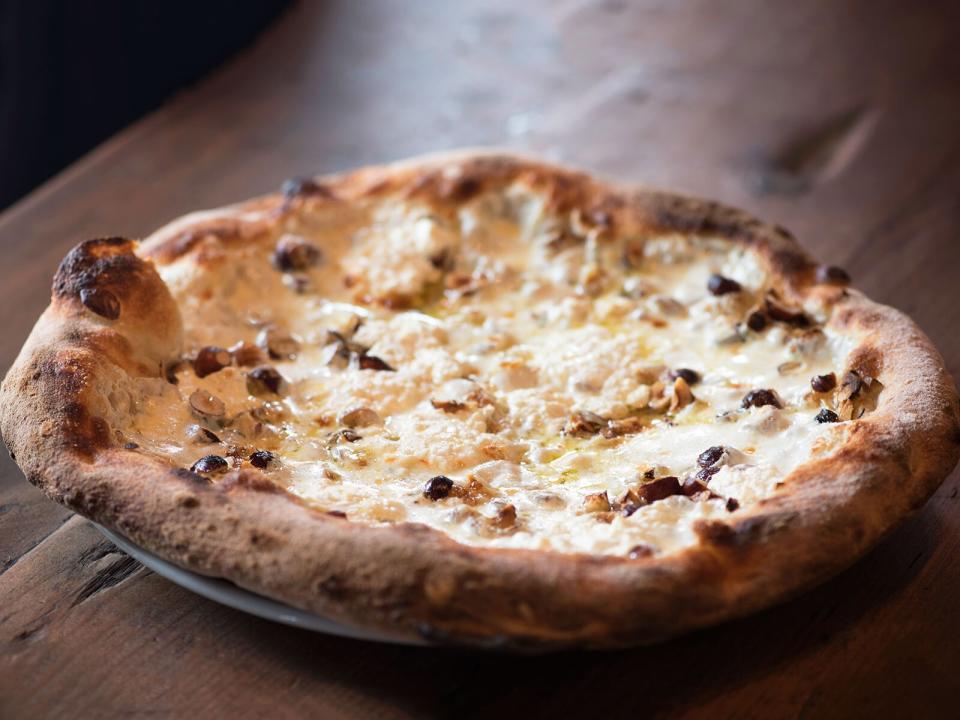
Courtesy of Robin and Sue
These days, the two best practitioners of the style can be found in suburban Robbinsville. There's Papa's, which dates to 1912, run by the Azzaro family, who will proudly tell you that this is the oldest, continuously-operating, family-owned pizzeria in the United States. If you really want to throw it back, ask them about putting mustard on your pizza (seriously — it's kind of a tradition here). Practically around the corner, you have DeLorenzo's Tomato Pies, which until recently still operated out of a memorably outdated space in the old neighborhood. These days, the same magic still happens, the same way it has since 1947. Don't let the modern premises fool you; this is one of the finer classic pies in the entire Northeast.
New Mexico: Red and green chile
One of the best food-focused road trips in the country happens around harvest time in Hatch, home of America's most famous green chiles. Drive into the dusty, Southern New Mexico town in late summer and you'll leave with your eyes watering and your sinuses cleared, what with all the roasting going on. Not that you have to trek all the way to one town to try one of the state's favorite things to eat. Many classic New Mexican restaurant hangs around on the strength of its chile, the only question being, red or green? The Barelas Coffee House in Albuquerque is renowned for both, best consumed with puffy, freshly pressed flour tortillas. At Mary & Tito's, another Burque institution (since the early 1960s), red is the star, along with, once again, the house tortillas. At The Shed, just off the Square in Santa Fe since 1953, the color of the day is always green.
New York: Pastrami
Behind every person thrilled to be going to Katz's, there's probably somebody else trying not to panic. America's best-known deli is famously confounding, crowded, loud, and fast, with a primitive ticketing system seemingly designed to terrify the uninitiated. Drill down, past the noise, the clamor, the yelling, and focus on what really matters, which is the pastrami itself. Sensitively rubbed, smoked, steamed, and sliced like by hand, this is New York's most essential food, at its finest. There are no short cuts here, and you can tell when you dig in, the meat practically melting away as you go in for that first bite. They could serve this pastrami on a barge in the middle of the East River in January, and we'd probably swim there — at least there would be more breathing room. If you think there's a more iconic New York sandwich than the pastrami on rye with mustard, you may need a refresher course on what New York is actually about. The list of great delis is shrinking by the year, but if you know where to look — from Liebman's in The Bronx to Frankel's, a fine new-waver in Greenpoint, Brooklyn — you're never all that far from happiness.
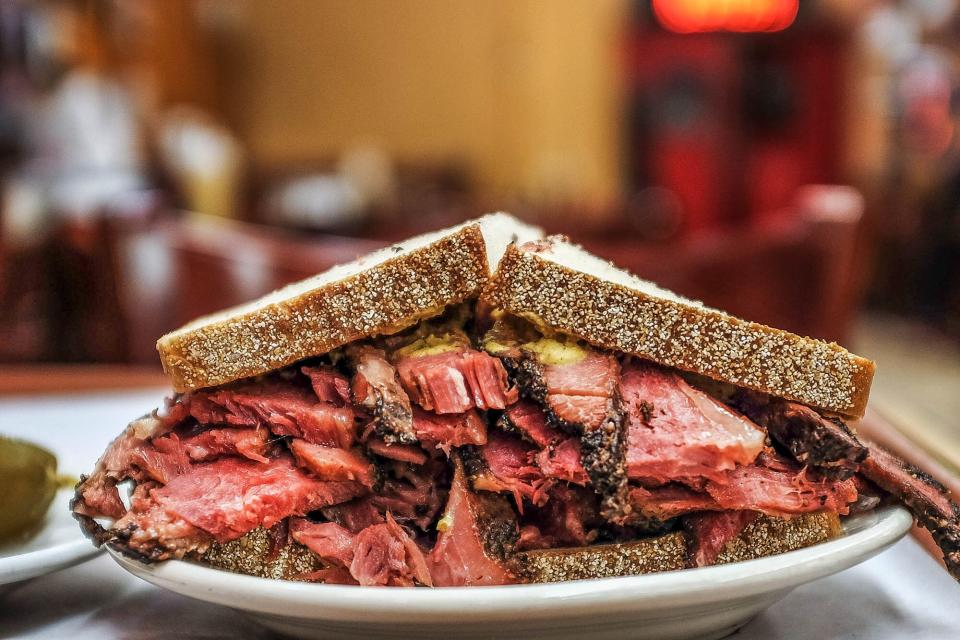
Spencer Platt / Getty Images
North Carolina: Whole hog barbecue
Long before Americans talked casually among themselves about the joys of balancing fat and acid, before artfully arranged brisket trays became an Instagram holy grail, there was that little paper boat stack at Ayden's Skylight Inn. It's a thing of simple beauty, almost unparalleled in American barbecue — a nest of finely chopped, lightly seasoned whole hog, cooked over oak for 18 hours, with that coleslaw, that minimalist slab of cornbread, looking like an ancient snack. Forget, for a moment, the rest of barbecue. Whole hog, as expressed in the eastern heartlands of North Carolina, remains perhaps our closest link to the craft as practiced back at the very beginning, and Skylight is the oldest surviving practitioner in region, dating back to 1947, when a teenaged Pete Jones set up shop on a piece of family property. Today, this is one of three essential stops in the area, the other two being Sam Jones BBQ, closer to Greenville, that's Pete's grandson, and you've also got Grady's in Dudley, where Steve and Gerri Grady have been doing things the right way since the 1980s.
North Dakota: Chocolate-covered potato chips
Named for the unruly waterway dividing North Dakota and Minnesota, the Red River Valley is sort of the Idaho of the upper Midwest, laying claim as the nation's largest producer of red skin potatoes, which probably comes in handy during the long winter months, when whatever lasts in cold storage is what you end up eating. Those long winters appear to have given North Dakotans plenty of time to be creative about new ways to use up the year's crop, which we're imagining is how chocolate-covered potato chips became the favorite snack in the Red River city of Grand Forks. Carol Widman's Candy Co. has been around since 1885, an achievement largely due to the creation (and perfection) of their Chippers — flavorful local potatoes, ruffle cut and fried, then enrobed in milk or dark chocolate. Your move, every other candy maker in America.
Ohio: Cincinnati chili
Mark Twain apparently once joked that when he died, he hoped he'd be in Cincinnati, which was always twenty years behind the times. In the case of the city's chili culture, I'd say about fifty. The story of this obscure regional quirk is a terribly American story, a story of immigrant entrepreneurs. The stuff beloved by generations of locals, and much misunderstood by outsiders, began life as a Greek-American thing, a vaguely Mediterranean-spiced sauce served on top of hot dogs — evolving, then spawning, over time. Today, the very best versions are found in the humble one-off parlors, but there's something special about the dueling chains, Gold Star and Skyline, still so committed to their extremely specific craft. While you might have never tried this, and may never again, a three-way, consisting of a healthy portion of chili atop a pile of spaghetti, served with an abundance of finely shredded cheddar, on a cold night in the dead of winter — that's peak Cincinnati. That's one of those weird, wonderful moments you won't soon forget.
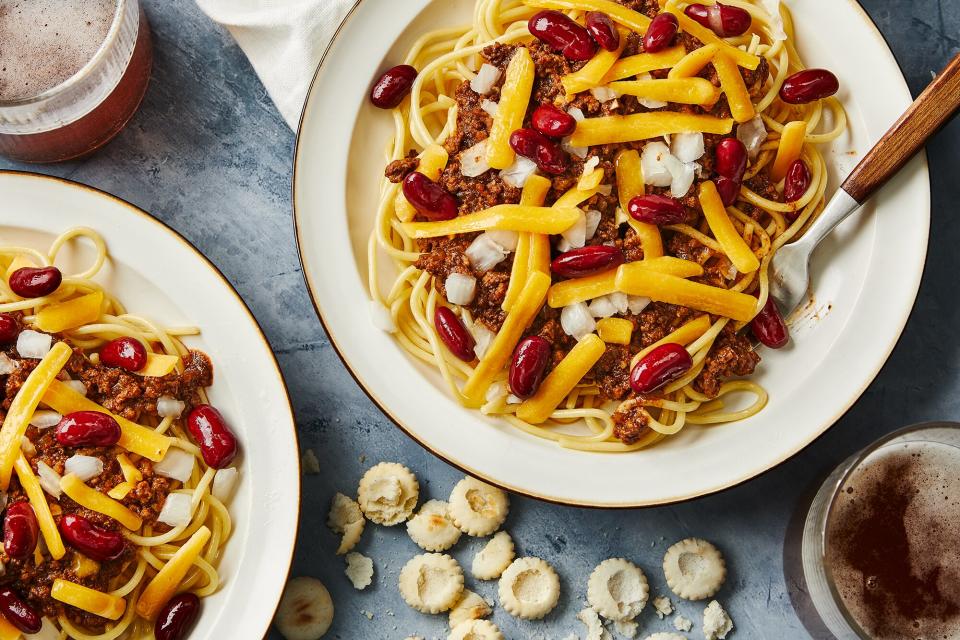
Photo by Greg DuPree / Food Styling by Melissa Grey / Prop Styling by Christina Daley
Related: Skyline Chili, and Cincinnati Chili in General, Explained by a Local As Best She Can
Oklahoma: Smoked bologna
Caught between some of the greatest barbecue states in the country, you've got to hand it to Oklahoma for sticking by its childhood sweetheart. Here, when you talk BBQ, you'll definitely end up talking smoked bologna. Served everywhere from nice restaurants to well-worn counter joints, what's sometimes jokingly referred to as "Oklahoma tenderloin" isn't just a local curiosity, it's a full-on, all-state passion. Take it off the menu, local restaurateurs will tell you, at your own risk. At Jamil's in Oklahoma City, nearly last of a breed of Lebanese-owned steakhouses that served hungry Oklahomans for years, the bologna sandwich — get it with a side of tabbouleh — is one of the top draws at lunch time. Up in Tulsa, the city's hottest 'cue joint, Burn Co. does an all-the-meats extravaganza, featuring yours truly, that could stop hearts from just looking at the thing.
Oregon: Blue cheese
Even generations ago, back when California was just starting to fill up, the smart money was looking north, to places like Oregon's sun-splashed Rogue Valley. It's here that the Vella family, Italian immigrants and big wheels down in Sonoma County (cheese-wise and politics-wise), decided to expand their commercial empire, taking over a struggling dairy back in the 1930s. For generations, Rogue Creamery ticked along, changing hands within the family, finally selling to an ambitious new owner a decade or so ago, one with a vision — to put Oregon squarely on the map as one of the finest producers of artisan cheese. It worked. The creamery's Rogue River Blue took home top global honors at the World Cheese Awards in 2019. This wasn't shocking win, either — sample your way around the United States, and there's one thing you'll figure out, fairly quickly, which is that we're having something of a blue cheese moment. In fact, it might be one of the things we do best. None better than what you'll find in Oregon, and specifically here. The king of Rogue's worthy cheeses, the prize-winning blue is aged for 9 to 11 months, hand-wrapped in Syrah grape leaves that are soaked in pear spirits, and then aged again. The results are nothing short of luxurious. The only thing that will stop you from eating an entire pound at a time is the cost; perfection doesn't come cheap.
Pennsylvania: Smorgasbord
The first thing you will notice stepping into the softly lit dining room at Miller's Smorgasbord in Lancaster County is that curved wall of windows at the back, looking directly out to Amish-owned farm fields. Some days a herd of well-kept cattle will graze just feet away from your table. On others, a young man will make his way up and down the rows in some sort of horse-drawn implement. This is the kind of agritourism everyone can get into, the kind where you don't get mud (or worse) on your shoes. Miller's has come a long way since it was founded in 1929, before the birth of mass tourism in Lancaster County, but here, as in so many other parts of the region, things remain essentially as they have for generations. Ask to be seated as close to the view as possible, then make your way to the pickle bar — you never knew so many vegetables could be pickled, definitely don't miss the watermelon or the chow chow — before easing your way in to the many-stationed buffet, immaculately kept and piled high with simple pleasures. Make yourself a classic spinach salad with sweet and smoky warm bacon dressing, go for fat slices of baked ham in a cider jus, grab a Pennsylvania Dutch-style chicken pot pie, and don't forget sides of grilled local vegetables often sourced directly from the neighbors.
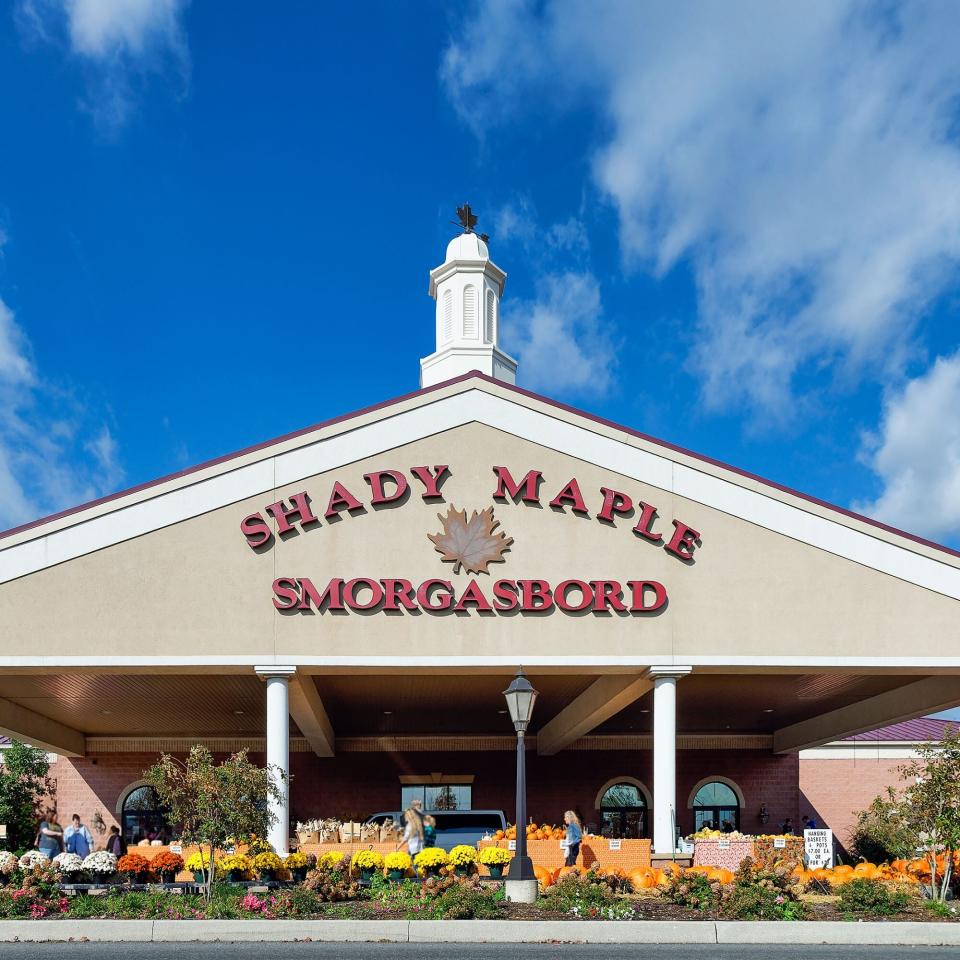
John Greim / LightRocket via Getty Images
The charm of Miller's isn't showmanship; the food and the experience are relentlessly straightforward. But an hour by the window here, watching this slower-paced world go by, and leaving more than well fed — this is about as restorative an experience as you could ask for. The fact that they're feeding you is almost a bonus. While not quite the largest buffet in the country, Marvin and Miriam Weaver's Shady Maple Smorgasbord, a seeing-is-believing, absolutely vast Lancaster County operation, which began as a humble farm stand in the 1960s, comes pretty darn close, boasting 110,000 square feet and a 200-foot buffet line that could feed thousands. In reality, the place holds about 1,200 people at a go, which is plenty, you will learn, if you come here on a busy Saturday, when the place can be more lively than the average airport concourse. Somehow, it all works, supplemented by four, very busy live-action grill stations, offering up enough diversity in the daily offerings that you will need to eat here at least twice before you work through your options. No matter which route you take, or routes, end things with a sliver of shoo-fly pie and a cup of strong, organic, locally-roasted coffee. Staying overnight? The extensive breakfast buffet here is quite the hit with hungry working locals; if you can get out of bed in time (the doors open right at six), do so.
Rhode Island: Stuffed Clams
If you grew up anywhere close to the ocean between South Jersey and Boston, baked clams were most likely a part of your childhood, and they were probably a little bit like the meatloaf you remember from back then: as much about everything else that went into the dish — So much breadcrumbs! So much garlic! — as the clam itself. Long Islanders, to name one of the homelands, might be surprised to learn this, but Rhode Island considers itself the home of the stuffed clam, or the stuffie, and to be quite honest, it's hard to beat a fresh quahog, topped with buttery, heavily-seasoned breadcrumbs mixed with finely chopped vegetables, right out of the oven or off the grill. They're served almost everywhere, but Aunt Carrie's in Point Judith, which also birthed the deep-fried clam cake, another Rhode Island icon, should be high on your list.
South Carolina: Shrimp and grits
Rooted deeply within the region's indigenous heritage, the soul-satisfying dish of shrimp and hominy, as it used to be called, seems like it has always been an essential part of the experience for visitors. And yet, it was only relatively recently when chefs in other places began taking an interest in the classic Lowcountry breakfast, combining two of the finest locally available ingredients, that chefs in South Carolina began to see the regional cuisine as a potential tourist lure. Even as late as the 1990s, things were relatively quiet on the Charleston food scene, the current state of things but a glimmer in the eye of trendsetters like Frank Lee, who opened the doors to Slightly North of Broad, known fondly around town as SNOB, early on in the decade. Lee has long since moved on, but the dish, marrying fresh tomatoes, country ham, and the house sausage with creamy, Edisto Island-milled grits and fresh Lowcountry shrimp, remains on the menu. There'd probably be a riot if it didn't.
South Dakota: Chislic
How did shashlik, or skewered cubes of lamb, beef, and venison, become the official state snack in one of the country's most sparsely populated places? The story is said to have begun in the late 1800s, when immigrants from Crimea introduced the popular nosh to South Dakota's East River region, which decided that chislic was a better name, and that cooking the meat on sticks dipped into hot oil was better than throwing a skewer on the grill. You'll find chislic all over, particularly in bars and restaurants around the Sioux Falls area, but for the real deal, trek out to rural cafés like Meridian Corner in Freeman, where the lamb and mutton are superb; so is everything else on the menu.
Tennessee: Hot chicken
Nearly a century before Nashville became one of the South's favorite food cities, the locals were blowing their own minds over baskets of hot chicken, messy and spicy and red with cayenne pepper. It would have been a serious failing had hot chicken not ascended along with the city, but who could have predicted it'd travel as well as it has — not just all over the country, but to foreign lands as well. So what if you can find it in San Diego and Sydney? We'll always brake for a moment to appreciate the classic article at the pioneering Prince's Hot Chicken, where accompanying pickles and white bread invite a make-your-own type situation. For a pre-assembled sandwich, we'll head to the new-school Hattie B's — perhaps best thought of as the South's answer to Shake Shack — for the hot chicken sandwich on a snazzy, locally-baked roll, topped with crunchy coleslaw, kosher dills, and a drizzle of the seductive house comeback sauce, a let's-try-this-at-home combo of honey, mayonnaise, and spices.
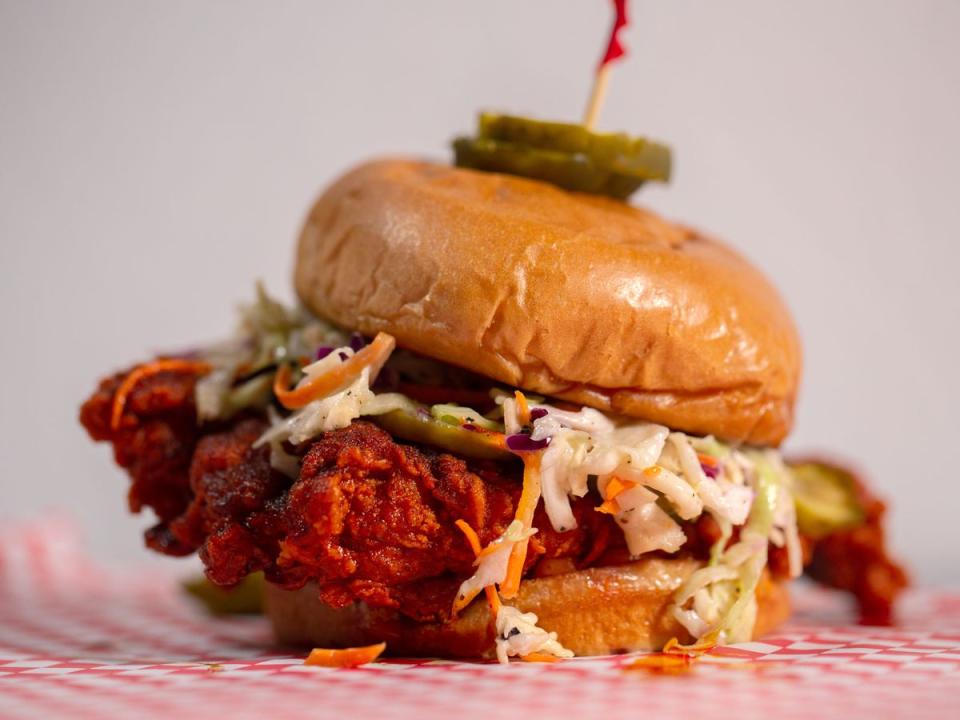
Alan Weiner
Texas: Brisket
Recent years have been exceptionally kind to barbecue, one bright young thing after another clambering into the pit, pushing the genre in all sorts of exciting directions. Truth be told, if you're eating brisket pretty much anywhere in Central Texas right now, or even in parts of the state like Fort Worth and Houston that weren't typically considered part of the barbecue belt, it is better than it's ever been. But for all the changing, for all the evolving and genre-bending and mind-expanding, there's still something deeply satisfying about a crawl through the small towns dotting the countryside east and southeast of Austin. Places like Lockhart kept the smokers going even at a time when proper barbecue seemed to be on the endangered list. You can eat well in a lot of places now, but it'll be a generation or two before most of the new crop can match the essential feel (and taste) of the extraordinary, pepper-crusted brisket at the likes of Louie Mueller BBQ, a fixture in the town of Taylor since the 1940s.
Utah: Pastrami burgers with fry sauce
Ask almost any long-time local on the east side of Los Angeles, and they'll be quick to claim ownership of the pastrami burger, that classic treat that appeared post-war in neighborhoods like Boyle Heights and older suburbs like Alhambra and Anaheim. Ask someone in Salt Lake City, and they'll be equally certain that the pastrami burger belongs to them. Here's the thing — both cities are correct. Los Angeles may have invented these retro flavor bombs, with assistance from transplanted New Yorkers, but it's Salt Lake that these days can be found celebrating them the most enthusiastically, going back to the 1980s when a family member from Southern California got involved in the fledgling Crown Burgers mini-chain, perfecting the recipe for the burger that would become the most iconic in the city. Known for classic, over-the-top decor varying slightly by location, one thing stays the same — the burger, which begins with a quarter pound of beef, griddled and covered in cheese, topped with another quarter pound of deeply pink pastrami, and ample amounts of fry sauce, that essential Utah condiment sometimes mistaken for Thousand Island dressing. (Close, but no.)
Vermont: Cheese
Surely other things get accomplished here, but it's hard to imagine Vermont's economy without the food- and drink-based small businesses that dot this idyllic, cozy state out, where it seems as if everyone that isn't into farming, hard cider, or maple syrup is into cheese. No place else in the country besides the West Coast has this same concentration of highly decorated artisanal makers. Nearly twenty years after brothers Andy and Mateo Kehler scraped together the money to buy a Northeast Kingdom dairy farm, Jasper Hill Creamery's trademark blue-labeled cheeses can be found at pretty much any decent monger around the country, and every one of them a winner, from the Stilton-style Bayley Hazen blue, to the spruce bark-wrapped Harbison, a gooey gem paying tribute to the formidable and funky Vacherin Mont D'Or. From iconic, crowd-pleasing cheddars at the non-profit Shelburne Farms to the hard-to-snag French Alps-inspired Tarantaise at Spring Brook Farm in Reading, you're never far from something truly memorable.
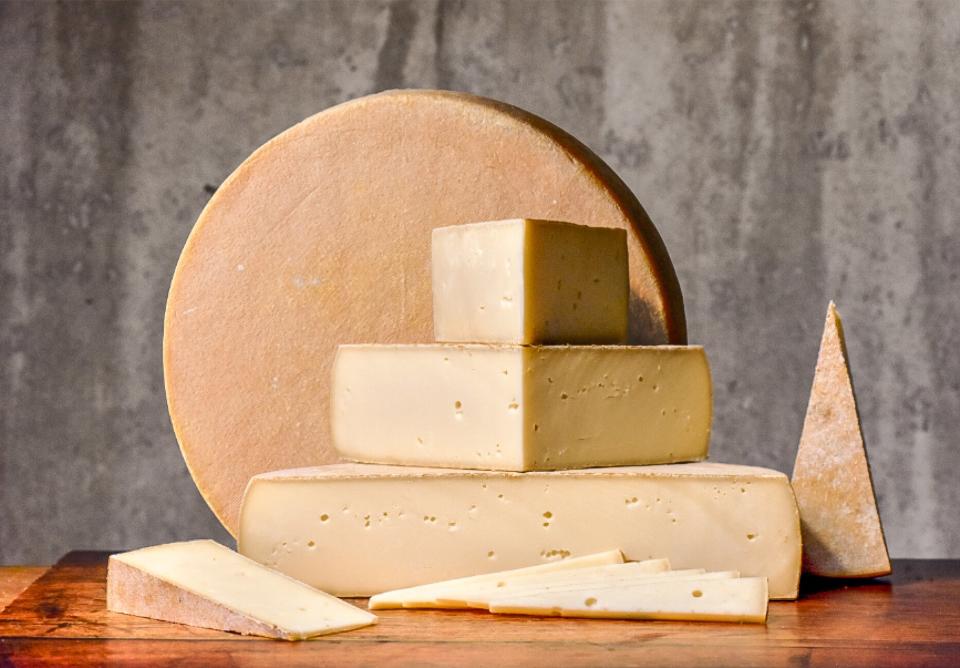
Courtesy of Jasper Hill Farm
Virginia: Ham
In a perfect world, the I-81 struggle through Virginia might have been ameliorated by modern conveniences, starting with a third lane in each direction. In the meantime, better to think of this essential leg of the Northeast to Deep South fast route in terms of the many small detours one can make in order to feel human again. These tiny escapes should involve — at least once — a dive into Virginia ham culture. One of our favorite spots will always be the frills-free experience at Fulks Run Grocery, just a short hop from the highway northwest of Harrisonburg. On Fridays they fry up slabs of the house specialty, but we'll take a country ham sandwich any day — salty, formidable, stacked on a bun. (Upgrade your experience, rather considerably, with their homemade pimento cheese.) Condemned to I-95 instead? Slow down for the ham on a roll at the delightfully antiquated Sally Bell's in Richmond, where after all this time they still sell a great box lunch, a kind of Southern-fried bento, lovingly assembled.
Washington: Seattle-style Teriyaki
Teriyaki is as close as Seattle will probably ever come to having its own style of barbecue. The Japanese essential, adapted for regional tastes in the 1970s by ex-wrestler Toshihiro Kasahara and to this day a Western Washington staple, remains as ubiquitous as Chinese takeout in New York City. The simplicity of the experience is one of the things that makes a teriyaki meal so pleasurable: flame-charred chicken and beef, generously marinated in soy sauce, rice wine (or vinegar), and sugar and garlic and ginger, artfully served atop quenelles of texture-perfect California Delta short grain rice. It's the Northwest's own gift to American takeout culture, but you'll still have to come all the way up here to see it done properly. Any day of the week he's open, your journey begins in suburban Mill Creek, where Kasahara, 73, is still the master of his craft at Toshi's Teriyaki Grill. Right in Seattle, you want the absolutely gleaming chicken from the Choice Deli in Ballard, while down near Tacoma, seek out Puyallup's Happy Teriyaki #11, a busy sit-down joint boasting a koi pond in the middle of the dining room.
West Virginia: Pepperoni rolls
France has the croissant. West Virginia? The pepperoni roll. Equally revered in their respective homelands, the latter may not have achieved the same notoriety elsewhere, but the humble workingman's lunch is only a century old, so give it time. The premise is simple: chunks, sticks, or slices of cured Italian sausage are plunged into sizable, soft white rolls. During the baking process, the spiced oil from the pepperoni seeps out into the bread, resulting in a bit of everyday magic. Highly portable and terribly satisfying, the rolls were popular down many a Mountain State mineshaft for generations. Today, you find them all over, starting with Fairmont's Country Club Bakery, which originated the local staple.

Stock Food / Getty Images
Wisconsin: Door County cherry pie
Sometimes referred to as the Cape Cod of the Midwest, laidback Door County, the 70-mile peninsula jutting way out into far northern Lake Michigan is extremely cherry focused, no matter the time of year. As you traverse the highways, and the exceptionally scenic backroads, heading towards the end of the line, you are likely to find yourself tempted by any number of cherry-related come-ons, but serious pie lovers know that for the very best, you keep going, all the way to Ellison Bay, where the humble, cinder-block hut that is home to Bea's Ho-Made Products has been standing for generations. In a world of shrinking pies, Bea's sticks up for the old ways, cranking out generous, 10-inch beauties made with hand-rolled, from scratch, lard laden crusts. (Pie, they like to remind you here, is not a health food.) You don't have to be a cherry person to make the pilgrimage— the bakery's apple pies are pretty terrific, as well.
Wyoming: Bison
With ranches the size of some small states and an equally expansive collection of national lands, Wyoming is the land of roaming buffalo. The American bison is the official state mammal, though this coveted designation is not enough to save them from the slaughterhouse. The lean, tasty alternative to beef can be found on menus (and in butcher shops) throughout the state. Feeding the region since the 1940s, Jackson Hole Buffalo Meat Co. will ship you a care package of the nutrient-dense bison meat, while restaurants in visitor hotspots like Jackson can reliably be found offering everything from massive steaks to house-made sausages.

